Most people think of Ohio as being a state with only cows and cornfields. However, did you know that Ohio is also home to some of the unique tree frogs in North America?
Tree Frogs are amphibians that can be found in many different parts of the world, and there are several different species that live in Ohio.
In this blog post, we will take a closer look at some of the most common tree frogs in Ohio state, and we will also discuss what makes them so special. So stay tuned!
6 Types Of Tree Frogs in Ohio
All around the beautiful state of Ohio, you will find different types of tree frogs. I will present to you with these six tree frog details that are widely available in Ohio.
With that said, let’s see what types of tree frogs are found in Ohio.
1. Spring Peeper
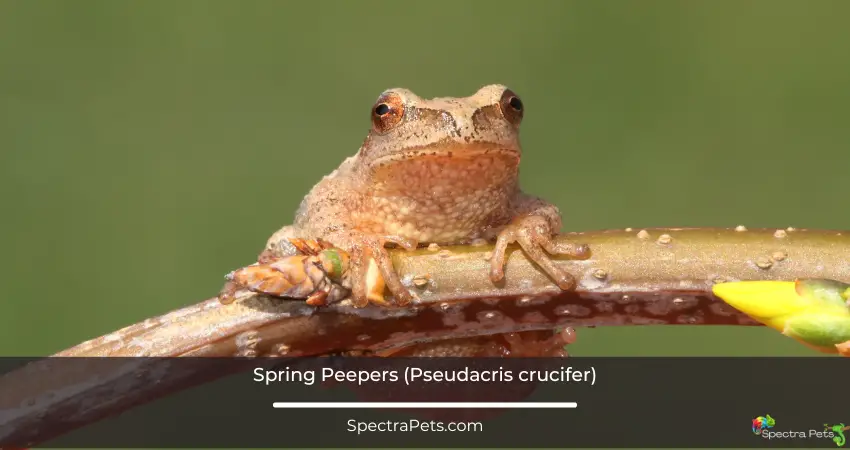
The spring peeper (Pseudacris crucifer) is a small frog about 1.5 inches in length. It is reddish, brown, or tan in color with dark spots on its back and sides.
Spring peepers have webbed feet and their toes are tipped with tiny round pads that help them climb. Male spring peepers have a dark “X” on their backs. This mark is used to attract females during the breeding season. These frogs are found in wooded areas near ponds or lakes. They feed on insects in the evening time. During the day, they hide in trees, shrubs, and tall grasses.
In terms of longevity, they don’t live very long—only 3-4 years—but they make up for it by having lots of babies! The male frog of the species is smaller than the female. Females have lighter skin color compared to male spring peeper frogs.
Breeding season for spring peepers begins in early April and lasts through May or early June. Females can lay up to 750-1200 eggs at a time! The eggs are laid in water and attached to aquatic plants so they don’t float away. One of the unique attributes of spring peepers is that frogs can survive in mind-boggling freezing weather like -8 degree celsius.
They can easily get into hibernate mood and for hibernation, they usually choose places like behind the bark of the tree or under tree logs. These incredible frogs’ diet mostly consists of flies, spiders, beetles, etc.
2. Boreal chorus frog
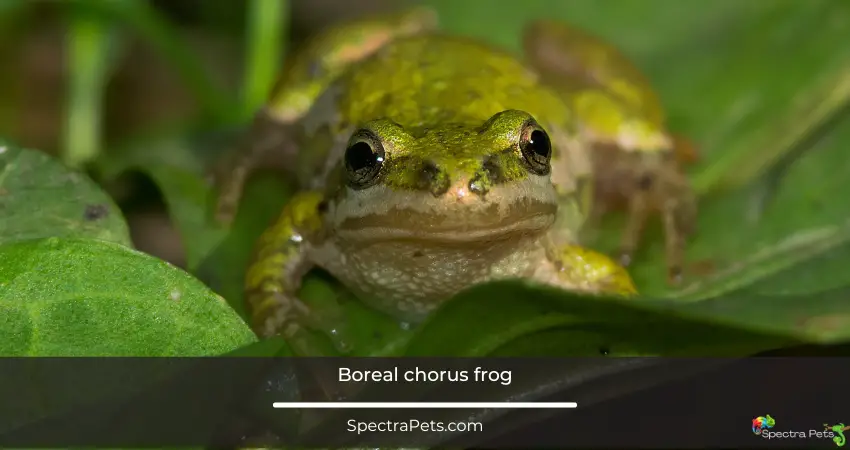
Boreal chorus frogs (Pseudacris maculata) are small amphibians that reach lengths of just 0.75-1.5 inches. They have a slim body shape with long hind legs that they use for jumping.
Their skin is smooth with striking black and white stripes that run along their backs. The males and females look similar, but females tend to be slightly larger than males. Males also have dark throats while females usually have light-colored throats.
Boreal chorus frogs are found in the northern parts of North America, particularly in Canada and the United States. They avoid areas with fast-moving water as this makes it difficult for them to climb on rocks or vegetation.
Moreover, these tree frogs are opportunistic eaters and eat mostly insects while larger individuals will also eat spiders, mites, centipedes, millipedes, and worms.
Boreal chorus frogs are nocturnal animals that spend most of their time hiding among vegetation near water sources. Although they are capable of climbing on rocks and trees, they prefer to stay close to the ground where they feel safer.
In optimal habitat conditions, boreal chorus frogs can live more than 3 years in the wild. However, most individuals only live for 1-2 years due to predation or disease.
Although these animals are common throughout their range, their populations have been declining in recent years due mainly to habitat loss and degradation. These frogs can survive harsh frozen winters and come back in the spring with full energy.
3. Mountain chorus frog
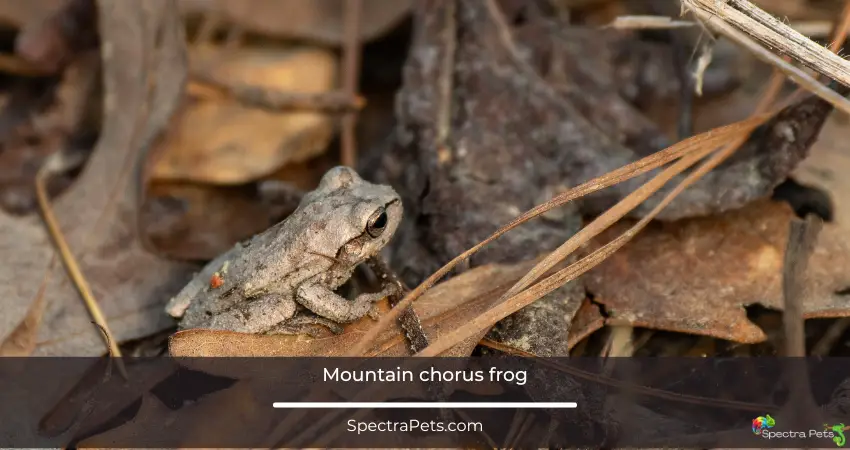
Mountain chorus frogs (Pseudacris brachyphona) are small frogs, usually only growing to be about 1-1.25” long. They have distinct dark brown or black blotches on their backs and sides, and their skin is smooth and shiny. Females are typically larger than males, but both sexes have similar markings. As you might guess from their name, mountain chorus frogs are found in the mountains—specifically, the Appalachian Mountains. They prefer habitats with dense vegetation where they can find plenty of places to hide from predators. Like furrows in plowed fields, mountaintop bogs, temporary pools, and roadside ditches.
Breeding season for these frogs usually begins in early April and lasts until late May. Mountain chorus frogs are nocturnal and mostly eat insects, such as beetles, crickets, and moths. Males will establish territories and try to attract females by singing a loud mating call. If a female likes what she hears, she will approach the male and allow him to fertilize her eggs. Once mating season is over, mountain chorus frogs go back into hiding until next spring rolls around.
The average lifespan of a mountain chorus frog is 4-5 years in the wild—but some captive specimens have been known to live for up to 8 years. These little guys face many dangers in the wild, including being eaten by snakes, birds, raccoons, and skunks—so it’s no wonder that so few of them make it to old age!
Adaptation perhaps the most striking thing about mountain chorus frogs is their ability to change color in order to better blend in with their surroundings and avoid predators.
4. Western chorus frogs
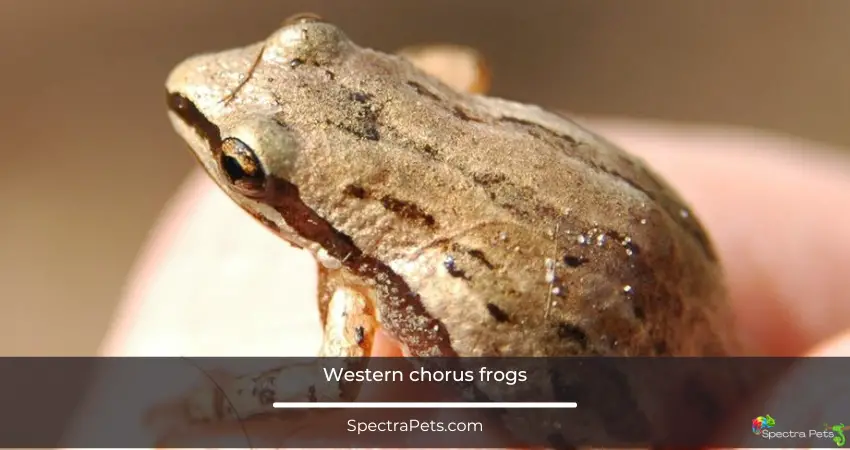
Adult western chorus frogs typically grow between 3/4” – 1 and 1/2”. They are variable in color, but most individuals are some shade of brown, gray, or olive green. The skin of western chorus frogs is smooth and moist, without any warts or ridges. As their name suggests, western chorus frogs (Pseudacris triseriata) are found in the western United States. They inhabit a variety of wetland habitats, including marshes, streams, ponds, and even ditches! They are especially common in areas with tall grasses or other vegetation that they can use for cover.
Western chorus frogs breed from late March through early June. During this time, the males will gather at breeding sites and vocalize to attract females. Once a female arrives, the pair will mate. The female will then lay her eggs in water and the eggs mostly get attached to the vegetation, where they will hatch into tadpoles.
In the wild, western chorus frogs don’t live more than 3 years. However, they can live up to 10 years in captivity! These frogs love hunting at night time.
Western chorus frogs have a number of adaptations that help them survive in their habitats. For example, their webbed feet allow them to swim quickly through the water. Additionally, the coloration of their skin helps them blend in with their surroundings and avoid being noticed by predators.
5. Cope’s gray tree frogs
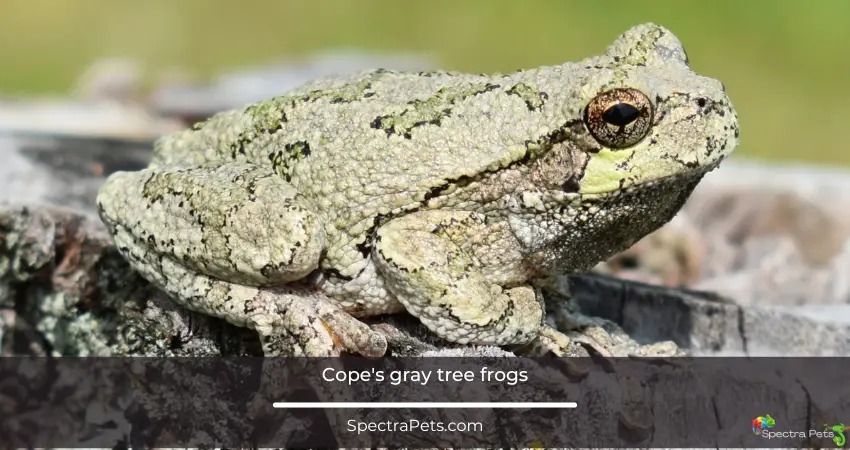
Cope’s gray tree frogs are small creatures, typically only growing to be about 1.25- 2 inches long. As their name suggests, they are usually gray in color.
However, their skin is capable of changing color to match their surroundings. This adaptation makes it very difficult for predators to spot them.
These frogs are mostly seen in the southern part of the state of Ohio state. Cope’s gray tree frogs are found throughout the eastern United States and parts of Canada. They prefer moist habitats and offer plenty of places to hide, such as dense forests or swampy areas. In the winter, they hibernate in trees or other elevated locations.
The breeding season for Cope’s gray tree frogs (Dryophytes chrysoscelis) typically takes place between May and August. Male frogs will sing mating calls to attract females. Once a female has been located, the pair will mate and the female will lay her eggs in a suitable body of water, such as a pond or stream.
Cope’s gray tree frogs are carnivores; their diet consists mostly of insects such as flies, mosquitoes, beetles, and moths. In the wild, Cope’s gray tree frogs have an average lifespan of 2.5 but in wild they can live up to 7 years. In captivity, however, they can live up to 10 years or more.
6. Gray tree frogs
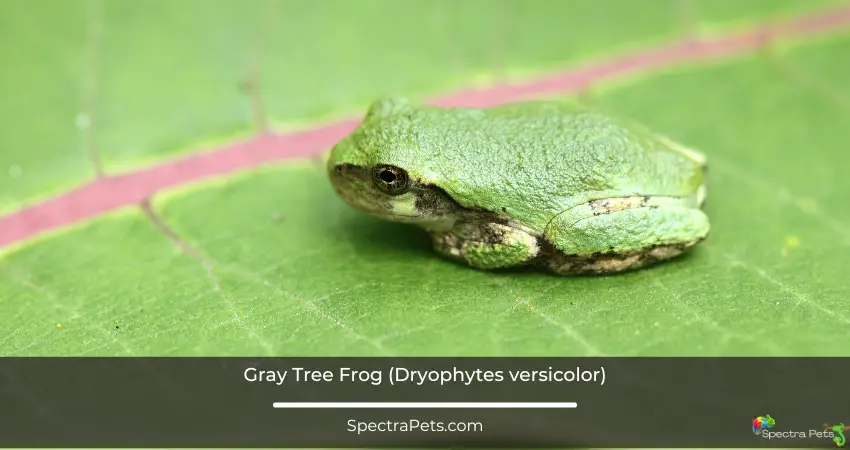
Gray tree frogs are small amphibians, measuring just 1.5-2 inches long from nose to tail. As their name suggests, these frogs are usually gray in color.
However, they can also be brown, olive green, or even yellow. The color change is controlled by special pigment cells in the frog’s skin.
When it’s hot outside, the cells spread out and the frog appears darker. When it’s cold or the frog is trying to blend in with its surroundings, the cells bunch up and the frog looks lighter in color. It is easy to find these species in Ohio. They prefer to live in moist areas such as woods near swamps or streams. During the day, they sleep clinging to the trunks or branches of trees. At night, they come down to the ground to hunt for food.
The breeding season for gray tree frogs (Dryophytes versicolor) lasts from late April to early August. Males will croak loudly to attract mates and establish territory. After mating, a female will lay her eggs on leaves that are floating on top of ponds or marshes. Within the next 8 weeks, the juvenile frog will be roaming around in the pond area.
Gray tree frogs are carnivores that eat insects such as beetles, moths, ants, crickets, and flies. They use their long sticky tongues to catch prey while they’re sitting still or leaping through the air.
Read More: Do Tree Frogs Change Color?
Wrapping up
I hope you learned something about these cute little tree frogs living in Ohio and how they are impacted by the changing climate.
It’s important to remember that even creatures as small as frogs play a vital role in our ecosystems, so we should do what we can to help them thrive.
And don’t forget to keep an eye out for those little green guys next time you go on an outdoor walk or camping.
Additional Read: Tree Frogs in Adjacent States To Ohio

